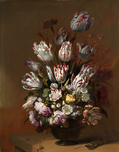
Introduction
Welcome. This guided tour takes you through the traces of The Hague's colonial and slavery past.
Here, around the corner in the Lower House of Parliament, Dutch slavery in Suriname and the Caribbean was abolished by law on 1 July 1863. That was the last penny in a long process for all Dutch colonies. Yet that abolition did not yet mean freedom for many enslaved people. For example, in Suriname, where they still had to work on the plantations for 10 years. For them, slavery only really stopped in 1873, just a century and a half ago.
All the Netherlands' colonial policies were made in The Hague. That is why you still come across places and buildings everywhere in the city centre where decisions were made and rulers lived. They also left thousands of documents and personal items, which are kept in Hague archives and museums. All these objects and locations bear witness to colonial history.
We accompany this walk with colonial stories from our Hague Municipal Archives. But in doing so, you should always be careful: many sources in the collection say more about the colonial outlook at the time than about the reality; the harsh reality in the distant colonies.
So take a walk through the centre of The Hague, where traces of citizens, administrators and their role in the city's colonial and slavery past can be found everywhere.
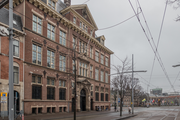
Kneuterdijk 24
On the corner of Kneuterdijk and Lange Vijverberg stands the former office of the Nederlandsche Handel-Maatschappij. It was founded in 1824 as a successor to the bankrupt V.O.C., to continue trade between the Netherlands and the colonies. And especially with the Dutch East Indies.
Take a moment to step away from the building so you can clearly see its architectural style. It was built in the early 1920s in a style inspired by the 17th-century Northern Dutch Renaissance. Note, for instance, the two heads next to the entrance and the decorated window frame that clearly shows tropical merchandise such as laurel and bananas, among others. A hundred years ago, it was not an issue to decorate buildings with this kind of colonial reference, while today we think very differently.
The Dutch Trading Company was an initiative of King William I, who was very fond of entrepreneurship. Not for nothing was its nickname: King Merchant. He was also closely involved in major national projects such as the construction of new canals and roads.
The Handel-Maatschappij was not only a trading company, but also a transporter and state banker all in one. And in the East Indies, it was also responsible for collecting taxes in kind, think sugar and spices. That stopped with Indonesia's independence in 1949 and the nationalisation of plantations by the Indonesian government. The Handel-Maatschappij did continue to exist as a bank and eventually merged into the Algemene Bank van Nederland, the A.B.N, one of the largest Dutch banking companies.

States of Holland
In this distinguished house at Kneuterdijk 24 lived Johan van Oldenbarnevelt, Dutch statesman and confidant of the Dutch Father of the Fatherland William of Orange, who was murdered in 1584, in the middle of the Eighty Years' War between the Netherlands and Spain. That war cost a lot of money and it had to come from somewhere. Together with Stadholder Prince Maurice - more or less the successor of William of Orange - Van Oldenbarnevelt therefore founded the United East India Company, the V.O.C., in 1602. Partly with its profits, the V.O.C. was able to pay for, and eventually win, the war against Spain, after which the Netherlands was internationally recognised as a sovereign state. But it's fair to say that without Van Oldebarnevelt and the V.O.C. money he secured for battle from this place, the Dutch would probably not have been able to drive out the Spaniards.
Things did not end well with Johan van Oldenbarnevelt himself. In 1617, he quarreled with Prince Maurice, whom he feared was planning a coup. Maurice then accused him of high treason and had his old friend arrested. On 13 May 1619, Johan van Oldenbarnevelt was beheaded at the Binnenhof.

Johannes Capitein
The restrained Kloosterkerk on Lange Voorhout has long been home church of the royal family. But it also played a role in the short life of Jacobus Capitein, a Ghanaian born in 1717 who was kidnapped as a child from Africa's west coast, sold to a captain of the West India Company and finally gifted to a Dutch merchant. Jacobus ended up in The Hague, where he was baptised in the Kloosterkerk in 1735. He then went on to study theology at Leiden, where he defended the thesis that: spiritual slavery was diabolical, but that physical slavery had God's blessing. Of course, the proponents of slavery fully agreed with this, and Capitein was sent as a reformed minister in the service of the W.I.C. to West Africa, where James died after five years at the age of 30.
In retrospect, we see the tragedy of his life in forced cleavage. But he himself may have seen it differently. In any case, this story shows that Bible texts on slavery were interpreted in many ways. By both supporters and opponents, the Bible was used to defend moral choices and justify or justify self-interest.

Family Tinne's home
The Tinne family's house at 32 Lange Voorhout looks austere among all its fancy neighbours, but appearances can be deceptive. The puissant rich Tinnes were merchants, ship owners, plantation owners and slave traders. In the early 19th century, Philip Tinne made a fortune importing sugar, molasses, coffee, rum and tropical hardwood from his South American plantations in Demerary - a Dutch colony where Guyana now lies. Philip did so with English business partners and their plantations had names like Vauxhall, Westminster, Diamond and Providence.
When the British abolished slavery in 1834, the Tinne & Co firm received compensation of 173,000 pounds from London for releasing all enslaved Africans on its plantations. That is now converted to about £126 million.
Meanwhile, production on Demerary's sugar plantations continued as usual, but now with Chinese and Indian contract workers as well as former enslaved Africans who continued to work as paid labourers. The company's fleet of more than 30 sailing ships transported the contract workers from India and China to Demerary and European passengers and goods to and from the Far East.
When Philip Tinne died in 1844, his daughter Alexine was eight years old and among the wealthiest Dutchmen of the time. Alexine was talented and had a keen interest in land and ethnography. She appeared in imaginative, self-designed dresses and with remarkable hats in public and rode fast on horseback across Lange Voorhout. Alexine pioneered as a photographer and became a famous explorer, most notably as one of the first Western women to cross Africa. She did take her canopy bed, her dogs and a whole procession of servants with her, but Alexine had a great aversion to slavery. She became angry when she herself was accused of it and, according to reports, she even bought 100 slaves free on one of her journeys. In 1869, the then 33-year-old Alexine crossed the Sahara with an expedition of 102 camels, but was ambushed and did not survive the attack.
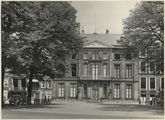
House of Patras
Patras' house - better known as the Palace on Lange Voorhout - was built in 1760 by order of Anthony Patras, a wealthy man with important positions within the V.O.C. for which he spent time Batavia. On his return to the Netherlands, Patras took a number of enslaved people with him. Their number is not known exactly, but they were probably five people who were made to work here in his house on Lange Voorhout as living proof of Patras' colonial status and power.
We can find very little information about these individuals in the Hague archives. We have only their names and some details.
These are them:
- Adriana Camonie: she came from/from Banja, she was baptised in the Nieuwe Kerk in 1746,
- Jan Kerkwijk: he came from Padam and he too was baptised in the Nieuwe Kerk in 1746,
- Jacoba Willemsie: born in Java and baptised in the Kloosterkerk in 1748,
- Hendrik Adriaans: from Bali, who professed his faith to the Reformed Church in 1747,
- Theodorus van Blasmy; also from Bali, baptised in the Grote Kerk in 1745, died at the age of 30 in the Pest- en Dolhuys in The Hague, in 1827 the name changed to Verbeterhuis.
That is all that can be found of these people; a few details, hidden deep in the records and archives of church and city - like the sparse traces of so many people of colour or people from colonised territories. Dry, factual information: a name, a place, a year for administrative purposes: one-sided, sparse and hurtful.
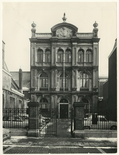
VOC - Bleijenburg 38
The Hague is not a port city, so you won't find VOC warehouses and other heritage of the trading companies here. But the administrations of the VOC and WIC (this should be written out in the translations and not with abbreviations, otherwise it will be incomprehensible to many visitors) did regularly travel from Amsterdam to the court city to meet. After all, trade was also political. The VOC was allowed to fight wars, conclude treaties and build forts, matters that had to be coordinated here with the States General and the stadholder of the Republic of the United Provinces. These meetings were called 'besogneren'. From 1690, the VOC used a building at 38 Bleijenburg, bought from Koenraad van Beuningen, former mayor of Amsterdam and former VOC administrator.
The 'Hague besogne' met here to read and answer correspondence from the East Indies. It was only about business mail, so not issues about the treatment of the local population, but for example about the number of ships to be built. Thus a colonial bureaucracy emerged at this place in The Hague, deciding on colonial matters at a great distance from the East Indies and with long delays.
After the VOC's bankruptcy, the Asian Council - later the Council of the Indies. held office here. After that, the building served as the Poorhouse for a while. In 1873 it was demolished and a new building was built on this site, the former Girls' High School you are now standing in front of. In an annex came the gymnasium, and it was there that a final memento of the VOC in The Hague was found in 1938: a 17th-century timepiece commissioned by the VOC and made by Amsterdam clockmaker Claudy Fremy.
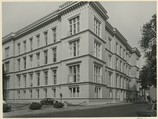
Ministry of Colonies
The Dutch colonies were part of the Kingdom of the Netherlands. Since the beginning of the 19th century, this kingdom was governed by ministries. The colonies also fell under their own ministry: the Ministry of Colonies. This ministry was housed in its own building at the address Plein 1, near the entrance to the Binnenhof and the Mauritshuis.
The Ministry of Colonies maintained administrative connections with the colonies. During the 19th century, the advent of steamships, telephony and telegraphy increased traffic between the Netherlands and the colonies. This caused many Indian officials to settle in The Hague, bringing with them Indian (culinary) culture.
The Hague also attracted many colonial businesses. Markets ('pasars'), stores, tokos and restaurants emerged. But also hotels and guesthouses for anyone with a connection to the colonies. The Hague thus developed into a city with a strong Indian identity.
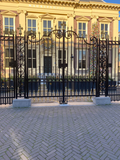
Mauritshuis - Plaats 29
The most famous symbol of Dutch colonial wealth in The Hague is the Mauritshuis, also known as the Sugar Palace - and with good reason. It was built between 1633 and 1644 by Johan Maurits van Nassau-Siegen, with the proceeds from the sugar cane plantations he ran as governor-general of Dutch Brazil. Johan Maurits also set up an extensive slave route between Africa and South America. The enslaved had to provide a steady flow of sugar cane, which boosted the sugar cane trade.
And all in the service of the WIC, which had been set up to break the Spanish and Portuguese power on the South American west coast. around 1630, the WIC conquered a large area from the Portuguese in north-east Brazil, christened it Dutch Brazil and received it from The Hague. It did not last long, as already in 1654 the Portuguese drove the Dutch out of Brazil again. Still, this was long enough to make Maurice wealthy. He was known for his
his tolerant attitude towards religion and great interest in and encouragement of art, culture and science, but Johan Maurits is mostly remembered for his close involvement in the Trans-Atlantic slave trade.